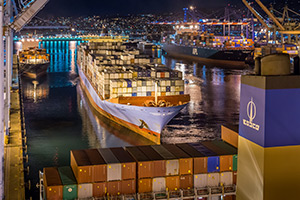February Container Volume Drops at Southern California Ports

Container volume at the Southern California ports of Los Angeles and Long Beach declined in February from a year ago because of backed-up congestion related to labor issues, the two said.
Cargo volume at the Port of Los Angeles fell 10.2%, and Long Beach’s plunged more than 20%. The sister ports make up the largest North American port complex.
Los Angeles said decline was due to terminal congestion and supply chain challenges during labor negotiations, which stalled late last year into early 2015 before a work agreement was reached between terminal operators and dockworkers.
The Pacific Maritime Association, which represents terminal operators, and the International Longshore and Warehouse Union reached a tentative agreement Feb. 20, but the backlog could take eight weeks to clear, port officials said after that deal was reached.
Imported containers at Los Angeles fell 10.7% to 254,225 20-foot equivalent units in February from a year earlier, while exports declined 10.3% to 131,806 TEUs. Factoring in empties, which fell 9%, overall February 2015 volume was 502,663 TEUs.
Long Beach’s overall container volume fell 20.1%, led by a 24.7% plunge in imports to 204,462 TEUs for February. Exports fell 22.9% to 110,711 TEUs.
Empty containers declined 3.9% to 97,941 TEUs. With imports exceeding exports, empty containers are sent overseas to be refilled with goods.
The congestion issues that worsened in February played the biggest role in the cargo declines, Long Beach said in its monthly report, noting that volumes saw a similar decline in January, when they dropped 18.8% year-over-year.
“However, the outlook is more promising,” the port said. “By the end of February, a tentative new contract for dockworkers was announced, federal regulators granted permission for Long Beach and its neighbor, the Port of Los Angeles, to collaborate on congestion relief and private chassis fleets in the region agreed to pool their resources.”
Long Beach said that last year was the third-busiest in its history, with a total of 6.82 million TEUs moved.

